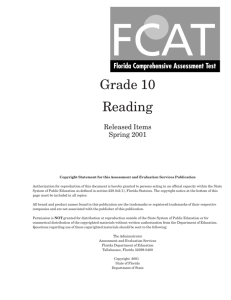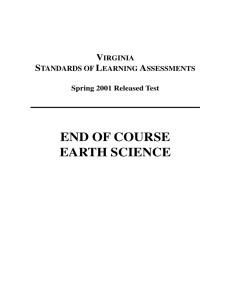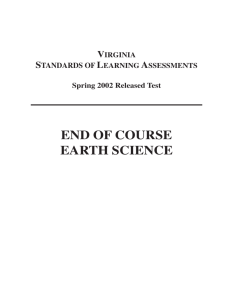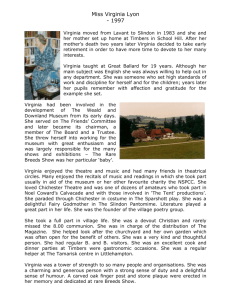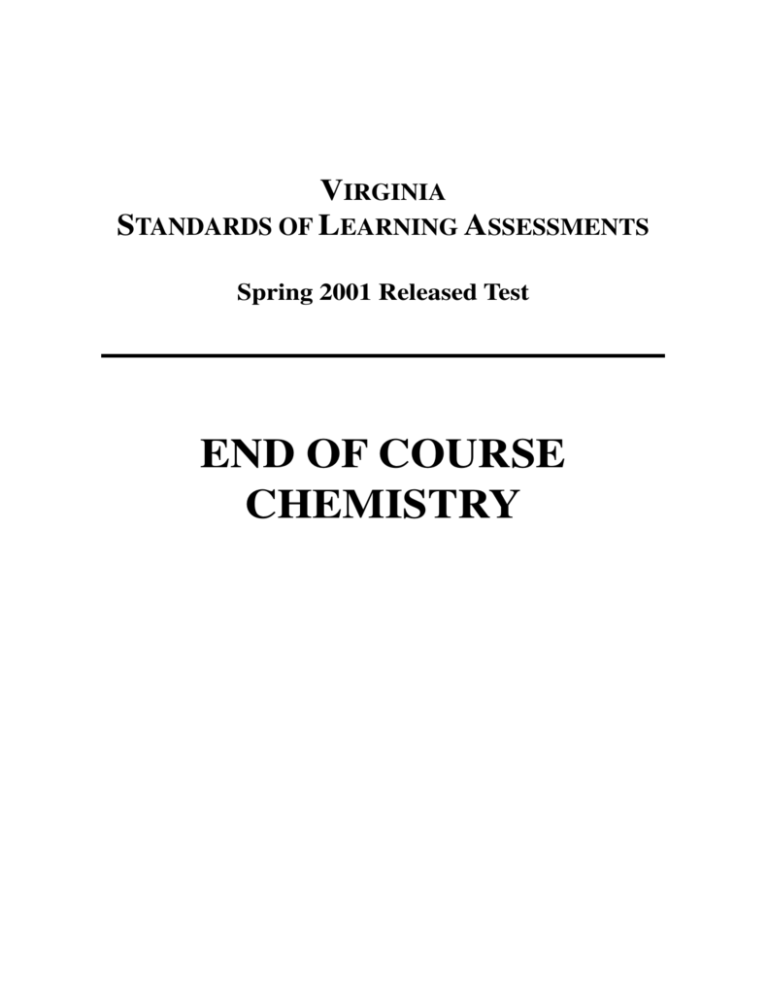
SESSION: 19 PAGE: 1 11/15/101 10:54 LOGIN IS-pam PATH: @sun1/xydisk2/CLS_psycorp/GRP_virginia/JOB_537591g11/DIV_g11ctest
VIRGINIA
STANDARDS OF LEARNING ASSESSMENTS
Spring 2001 Released Test
END OF COURSE
CHEMISTRY
SESSION: 19 PAGE: 2 11/14/101 8:38 LOGIN IS-pam PATH: @sun1/xydisk2/CLS_psycorp/GRP_virginia/JOB_537591g3/DIV_g3mathtest
Property of the Virginia Department of Education
䉷 2001 by the Commonwealth of Virginia Department of Education, James Monroe
Building, 101 N. 14th Street, Richmond, Virginia, 23219. All rights reserved. Except
as permitted by law, this material may not be reproduced or used in any form or by
any means, electronic or mechanical, including photocopying or recording, or by any
information storage or retrieval system, without written permission from the
copyright owner. Commonwealth of Virginia public school educators may photocopy or
print any portion of these Released Tests for educational purposes without requesting
permission. All others should direct their requests to the Commonwealth of Virginia
Department of Education at (804) 225-2102, Division of Assessment and Reporting.
SESSION: 17 PAGE: 3 11/12/101 12:58 LOGIN IS-pam PATH: @sun1/xydisk2/CLS_psycorp/GRP_virginia/JOB_537591g11/DIV_g11ctest
Chemistry
2
DIRECTIONS
CY03B102
Read each question carefully and choose the best
answer. Then mark the space on the answer
sheet for the answer you have chosen.
HCl ⫹ KOH → KCl ⫹ H2O
G Pb(NO3)2 ⫹ 2HBr → PbBr2 ⫹ 2HNO3
H C ⫹ O2 → CO2 墍
J Mg ⫹ H2SO4 → MgSO4 ⫹ H2
F
SAMPLE
墌
Which is an example of a synthesis
reaction?
CY03E301
墍
C
L
Which of the following is a balanced
equation?
C
3
H2 ⫹ Br2 → 2HBr 墍
B H2 ⫹ Br2 → HBr
C H2 ⫹ 2Br2 → 2HBr
D 2H2 ⫹ Br2 → HBr
A
3MgO ⴐ 2Al → ?
What would be the product(s) of this
reaction?
2Mg3Al2O3
B Mg3Al2 ⫹ 3O2
C 6Mg ⫹ Al3O2
D 3Mg ⫹ Al2O3 墍
CY01A407
墌
C
墍
C
A
1
CY03B406
To remove the sand first and then the
salt from a mixture of sand and salt
water, one combination of techniques
you could use would be to first —
evaporate and then distill
B evaporate and then condense
C filter and then evaporate 墍
D filter and then condense
A
3
SESSION: 17 PAGE: 4 11/12/101 12:58 LOGIN IS-pam PATH: @sun1/xydisk2/CLS_psycorp/GRP_virginia/JOB_537591g11/DIV_g11ctest
4
5
One of the main assumptions of the
kinetic molecular theory of gases is
that the particles of an ideal gas —
Fe3(SO4)2
B FeSO4
C Fe2(SO4)3 墍
D Fe2(SO3)3
A
CY05A106
墌
C
Which is the correct formula for iron
(III) sulfate?
must be single atoms instead of
molecules
G are in constant motion 墍
H must be maintained at very high
pressures
J must be highly chemically reactive
F
6
Which of these represents the
empirical formula and the molecular
formula, respectively, for a given
organic compound?
CH and C2H2 墍
G CH and CH4
H CH2 and C2H2
J CH3 and C3H12
F
4
CY03A302
墍
C
L
CY03C410
墍
C
SESSION: 17 PAGE: 5 11/12/101 12:58 LOGIN IS-pam PATH: @sun1/xydisk2/CLS_psycorp/GRP_virginia/JOB_537591g11/DIV_g11ctest
7
8
Specific Heat Capacities of Some
Common Substances
Substance
Specific Heat Capacity
(cal/g • oC)
Aluminum
0.21
Alcohol
0.58
Water
1.00
Wood
0.42
CY05F407
墌
C
CY03G407
墍
C
Beaker A
Beaker B
ArtCodes
CY03G407.AR1
Each beaker shown above contains
2.2 grams of iron and 1 liter of
3M H2SO4 at STP. Which reaction will
go to completion first and why?
What probably causes water to have the
highest specific heat of the substances
listed above?
Beaker A because of increased surface
area
G Beaker B because of increased surface
area 墍
H Beaker A because of a higher
concentration level
J Beaker B because of a higher
concentration level
F
Molecule size
B Molecular mass
C Strong hydrogen bonds 墍
D High density of ice
A
9
5
The element chlorine exists as two
naturally occurring isotopes. Cl-35
occurs 75% of the time and Cl-37
CY01G315
occurs 25% of the time. Which of the
墍
following calculations should be used
C
to calculate the correct average atomic
mass of chlorine?
A
(35 amu ⫻ .75) ⫹ (37 amu ⫻ .25) 墍
B
(35 amu ⫻ 3) ⫹ 37 amu
2
C
(35 amu ⫻ 3) ⫹ 37 amu
3
D
35 amu ⫹ 37 amu
2
SESSION: 17 PAGE: 6 11/12/101 12:58 LOGIN IS-pam PATH: @sun1/xydisk2/CLS_psycorp/GRP_virginia/JOB_537591g11/DIV_g11ctest
10
CY05A408
墌
C
12
The average kinetic energy of a sample
of water molecules is —
increased as the temperature is
decreased
G increased as the temperature is
increased 墍
H unaffected by temperature changes
J always equal to zero
F
11
墌
13
H
1.0
ArtCodes
0.9
2.0
2.5
3.0
1.2
1.5
1.8
2.1
Na Mg Al Si P
0.8
C
L
Radioactive iodine-131 has a half-life of
eight days. The amount of a 200.0 gram
sample left after 32 days would be —
CY02B407
1.5
3.5
6.25
B 12.5
C 25.0
D 50.0
4.0
A
Li Be B C N O F
CY02F315.AR1
墍
9.9 g
G 9.95 g 墍
H 10.0 g
J 10.00 g
2.1
C
L
CY01G330
F
Electronegativity Values
of Some Atoms
CY02F315
The mass of an object was recorded as
9.93 g, 9.90 g, and 10.02 g, using an
electronic analytical balance. What is
the average of these three masses
expressed to the correct number of
significant figures?
1.0
K Ca
2.5
3.0
S Cl
2.4
g
g墍
g
g
墍
C
2.8
Se Br
Electronegativity differences are often
helpful in determining the bond
character between two atoms. A
general rule states that if the
electronegativity difference between
two atoms is greater than 1.67, an ionic
bond would most likely be formed.
Using the chart above, which pair of
atoms would probably form the
strongest ionic bond?
14
2H2S (g) ⴐ 3O2 (g) → 2H2O (g) ⴐ
2SO2 (g)
CY04B306
If 3.50 g of H2S are used in the above
reaction, what will be the theoretical
yield of water in grams?
0.102 g
G 0.185 g
H 1.85 g 墍
J 185 g
F
Al-P
B Na-Cl
C K-F 墍
D Ca-O
A
6
墍
C
L
SESSION: 17 PAGE: 7 11/12/101 12:58 LOGIN IS-pam PATH: @sun1/xydisk2/CLS_psycorp/GRP_virginia/JOB_537591g11/DIV_g11ctest
15
17
Which of these describes a tendency
for atomic radii as displayed on the
periodic chart?
CY02F401
墌
C
Atomic radii decrease left to right across
a period. 墍
B Atomic radii increase left to right across
a period.
C Atomic radii decrease top to bottom
down a group.
D Atomic radii increase, then decrease
from top to bottom down a group.
A solution contains 225 g of glucose,
C6H12O6, dissolved in enough water to
make 0.825 L of solution. What is the
molarity of the solution?
A
0.66
B 0.97
C 1.03
D 1.52
A
18
16
evaporating dish ⴐ watch glass
42.70 g
A student wanted to calculate the
formula for hydrated copper sulfate.
After careful massing, she heated
the compound to remove the water.
She calculated the formula to be
CuSO4 ⴢ 4H2O. The actual formula was
CuSO4 ⴢ 5H2O. What is the most likely
source of analytical error in the
student’s experiment?
evaporating dish ⴐ watch glass
ⴐ NaHCO3
45.20 g
F
evaporating dish ⴐ watch glass
ⴐ NaCl
44.45 g
NaHCO3(s) ⴐ HCl(aq) → NaCl(aq) ⴐ
CO2(g) ⴐ H2O(g)
CY01G404
墌
Data Table
C
0.75
G 1.75
H 2.25
J 2.50
墍
C
CY01D203
墍
C
The water was not completely
evaporated from the compound. 墍
G The actual mass of the anhydrous
CuSO4 was less than the measurement.
H The CuSO4 reacted with elemental
copper.
J The atmospheric pressure prevented
complete reaction.
A student conducted an experiment
and was interested in the mass of the
product of the chemical reaction. Some
results of the experiment are shown
above. What is the mass of the NaCl?
F
M
M
M
M墍
CY04E407
g
g墍
g
g
19
What is the percentage of aluminum in
aluminum oxide (Al2O3)?
47%
B 48%
C 53% 墍
D 54%
A
7
CY01G410
墍
C
SESSION: 17 PAGE: 8 11/12/101 12:58 LOGIN IS-pam PATH: @sun1/xydisk2/CLS_psycorp/GRP_virginia/JOB_537591g11/DIV_g11ctest
20
23
Polonium
in lead box
50
>90°-occasional
CY02I408
C
CY05D406
墍
25
Alpha particles
ArtCodes
Temperature
(°C)
墌
Gold
foil
CY02I408.AR1
C
ArtCodes
0
CY05D406.AR1
–25
Fluorescent
screen
0°-many
<90°-few
5
Which of these conclusions can be
drawn from Rutherford’s experiment?
10
15
20
25
Time
(min)
Each atom contains electrons.
G The nucleus of an atom can be split.
H Each atom contains protons.
J Atoms are mostly empty space. 墍
F
An experiment yielded the above
temperature and time information.
What is the freezing point of the
material in this experiment if the
material is a solid at time zero?
⫺25⬚C
B 0⬚C 墍
C 25⬚C
D 50⬚C
A
21
CY02B409
墌
C
How does the radioactive isotope C-14
differ from its stable counterpart C-12?
It has a different number of protons and
two less neutrons than C-12.
B It has the same number of protons and
two more electrons than C-12.
C It has the same number of protons but
two more neutrons than C-12. 墍
D It has a different number of protons and
two more neutrons than C-12.
A
24
How many milliliters of 2.00 M H2SO4
are needed to provide 0.250 mole of
H2SO4?
CY04E409
125 mL 墍
1
G 1.25 x 10 mL
3
H 8.00 x 10 mL
J 8.00 mL
F
22
A compound has 50% sulfur and 50%
oxygen. What is its empirical formula?
SO4
G S2O4
H SO3
J SO2 墍
CY03C310 F
墌
C
L
8
墍
C
SESSION: 17 PAGE: 9 11/12/101 12:58 LOGIN IS-pam PATH: @sun1/xydisk2/CLS_psycorp/GRP_virginia/JOB_537591g11/DIV_g11ctest
25
CY03E405
墌
C
27
A(s) ⴐ B(s) → D(g) ⴐ heat
The reaction shown above is —
Displacement
Mass Data for Data for Sample
Group Sample X (g)
X (mL)
an endothermic reaction
B an exothermic reaction 墍
C a decomposition reaction
D a double-replacement reaction
A
1
2.7
3.4
2
1.20
1.5
3
6.2
7.40
CY01G402
墍
C
According to the above data, which of
the following represents the average
density for sample X using the correct
number of significant figures?
26
Chlorine forms a 1– ion. How many
electrons does a chloride ion have?
1 g/mL
B 0.8 g/mL
C 0.81 g/mL 墍
D 0.821 g/mL
A
1
G 16
H 17
J 18 墍
CY02C202 F
墌
C
28
CH4 ⴐ 2O2 → CO2 ⴐ 2H2O
The number of grams of oxygen required CY04B407
墍
for the complete combustion of 4.00
C
grams of methane (CH4) is —
4.00
G 8.00
H 16.0
J 32.0
F
9
g
g
g墍
g
SESSION: 17 PAGE: 10 11/12/101 12:58 LOGIN IS-pam PATH: @sun1/xydisk2/CLS_psycorp/GRP_virginia/JOB_537591g11/DIV_g11ctest
29
31
I
II
III
IV
?
CY03C409
墌
CY04G406
墍
C
C
ArtCodes
CY03C409.AR1
0.5 M NaCl
Which of the groups below has the
electron dot structure shown above?
1.5 M NaCl
0.5 M C6H12O6
1.5 M C6H12O6
ArtCodes
CY04G406.AR1
Four aqueous solutions and their
concentrations are shown in the above
illustration. Which of the solutions is
most likely to be the strongest
conductor of electricity?
Noble gases
B Halogens 墍
C Alkali metals
D Transition elements
A
I
B II 墍
C III
D IV
A
30
CY01B306
墌
C
L
A student must make a 3 M acid
solution using a 5 M acid solution.
Which of these is the safest way to
make the solution?
Slowly pour the 5 M acid into water 墍
G Slowly add water to the 5 M acid
solution
H Mix half the acid with water, then add
the remaining water
J Mix half the water with the acid, then
add the remaining acid
F
32
Water can be made to boil above its
normal boiling point of 100ⴗC by —
decreasing the air pressure
G increasing the air pressure 墍
H increasing the heat being applied
J decreasing the volume of the container
F
33
CY05A407
墍
C
What is the first step that should be
taken when a caustic chemical gets
into a person’s eye?
CY01C201
Identify the chemical
B Call for an ambulance
C Flush the affected area with water 墍
D Apply a neutralizing agent
A
10
墍
C
SESSION: 17 PAGE: 11 11/12/101 12:58 LOGIN IS-pam PATH: @sun1/xydisk2/CLS_psycorp/GRP_virginia/JOB_537591g11/DIV_g11ctest
34
CY03D412
墌
36
Melting and Boiling Points of Some
Bond Types
Substance
Type of
Bond
catalyst decreases the number of
collisions in a reaction
G activation energy of the reaction is
lowered in the presence of a catalyst 墍
H catalyst decreases the concentration of
the reactants
J temperature of the reaction increases
due to the catalyst
Boiling Melting Phase
Point
Point at 24ⴗC
F
C
Helium
atom
-269⬚C
(monatomic)
-272⬚C
gas
Hydrogen
molecule
(nonpolar
covalent)
-253⬚C
-259⬚C
gas
Iron
atom
(metallic
crystal)
3000⬚C 1535⬚C
solid
Sodium
chloride
ionic
crystal
1413⬚C
800⬚C
solid
Water
molecule
(polar
covalent)
100⬚C
0⬚C
liquid
37
According to the table, which of these
probably has the strongest bonds?
C2H10O 3
B C5H5O3
C C5H10O2 墍
D CH3O3
Hydrogen gas
G Iron crystals 墍
H Sodium chloride
J Water
38
CY04F302
墌
C
L
A compound is composed of 58.8% C,
9.8% H, and 31.4% O, and the molar
mass is 102 g/mol. What is the
molecular formula for this compound?
A
F
35
A catalyst accelerates a chemical
reaction because the —
In the reaction 2SO2 (g) ⴐ O2 (g) ⇔
2SO3 (g), which change would cause
the greatest increase in the
concentration of SO3?
125 mL
1
G 12.5 ⫻ 10 mL
2
H 1.25 ⫻ 10 mL
3
J 1.25 ⫻ 10 mL 墍
Decrease the concentration of SO2
B Decrease the concentration of O2
C Increase the concentration of SO2 墍
D Increase the concentration of O2
11
墍
C
CY03C306
墍
C
L
Which of these shows a volume of 1.25
liters expressed in milliliters?
F
A
CY03G409
CY01G401
墍
C
SESSION: 17 PAGE: 12 11/12/101 12:58 LOGIN IS-pam PATH: @sun1/xydisk2/CLS_psycorp/GRP_virginia/JOB_537591g11/DIV_g11ctest
39
CY02D307
墌
C
L
An element has an electron
configuration of 1s22s22p63s2. Which of
these will be in the same group as this
element?
43
CY05A103
increases four times
B decreases by one-fourth
C is doubled
D is halved 墍
A
2
2
6
1s 2s 2p
2
2
6
2
6
2
B 1s 2s 2p 3s 3p 4s 墍
2
2
6
1
C 1s 2s 2p 3s
2
2
6
2
6
D 1s 2s 2p 3s 3p
A
44
40
Very Active Metal ⴐ Water → Metal
Hydroxide ⴐ ?
Which of these completes this reaction?
Oxygen
G Hydrogen 墍
H Metal oxide
J Air
墌
C
42
CY05E408
墌
C
If the temperature of a reaction is
increased, the reaction proceeds at a
much quicker rate because the —
CY03G308
F
CY02F405
C
L
墍
activation energy increases
C
G energy of the products increases
L
H frequency of collisions between reactants
increases 墍
J energy of the activated complex
increases
C
41
墍
F
CY03E416
墌
If the pressure exerted on a confined
gas is doubled, then the volume of the
gas —
Which of these elements is the most
chemically active?
45
A catalyst
B A base
C An acid 墍
D An organic compound
A
F墍
B Cl
C Br
D I
A
If the heat of fusion of water is
3.4 ⴒ 102 J/g, the amount of heat energy
required to change 15.0 grams of ice at
0ⴗC to 15.0 grams of water at 0ⴗC is —
3.4
G 2.4
H 5.1
J 1.0
F
⫻
⫻
⫻
⫻
The formula H2SO4 is representative of
which of the following?
2
10
103
103
104
46
NH4Cl 墍
G MgBr2
H CH4
J NH3
12
墍
C
Which compound contains both ionic
and covalent bonds?
F
J
J
J墍
J
CY03A410
CY03D405
墍
C
SESSION: 17 PAGE: 13 11/12/101 12:59 LOGIN IS-pam PATH: @sun1/xydisk2/CLS_psycorp/GRP_virginia/JOB_537591g11/DIV_g11ctest
47
49
Which volume will be occupied by a
gas containing 6.02 ⴒ 1023 atoms at
STP?
CY04A407
1.0 L
B 11.2 L
C 22.4 L 墍
D 44.8 L
A
48
hydroxide
Key
i = nearly insoluble
ss = slightly soluble
s = soluble
n = not isolated
chromate
C
C
Some Solubilities in Water
chloride
墌
墍
93.33 kPa
B 96.00 kPa 墍
C 98.66 kPa
D 101.33 kPa
carbonate
CY03E402
CY05C405
A
bromide
C
acetate
墌
A sample of oxygen gas is collected
over water at 22ⴗC and 98.67 kPa
pressure. If the partial pressure of the
water is 2.67 kPa, the partial pressure
of the oxygen is —
s
n
s
n
i
s
s
s
s
s
s
i
s
i
s
s
i
s
s
ss
s
i
s
i
i
s
i
s
n
i
50
CY04G410
1
G 7 墍
H 10
J 14
F
ArtCodes
ss
Aluminum
Ammonium s
s
Barium
s
Calcium
Copper (II) s
s
Iron (II)
CY03E402.AR1
The hydrogen ion concentration is
ⴑ
1 ⴒ 10 7. What is the pH of this
solution?
Using the chart above, which of these
combinations will probably form a
precipitate?
Ammonium chloride
G Barium bromide
H Calcium chromate
J Copper (II) carbonate 墍
F
13
墍
C
SESSION: 17 PAGE: 14 11/12/101 12:58 LOGIN IS-pam PATH: @sun1/xydisk2/CLS_psycorp/GRP_virginia/JOB_537591g11/DIV_g11ctest
Answer Key
Test
Sequence
Correct
Answer
Reporting
Category
Reporting Category Description
1
C
001
Scientific Investigation
2
H
003
Nomenclature, Chemical Formulas, and Reactions
3
D
003
Nomenclature, Chemical Formulas, and Reactions
4
G
005
Phases of Matter and Kinetic Molecular Theory
5
C
003
Nomenclature, Chemical Formulas, and Reactions
6
F
003
Nomenclature, Chemical Formulas, and Reactions
7
C
005
Phases of Matter and Kinetic Molecular Theory
8
G
003
Nomenclature, Chemical Formulas, and Reactions
9
A
001
Scientific Investigation
10
G
005
Phases of Matter and Kinetic Molecular Theory
11
C
002
Atomic Structure and Periodic Relationships
12
G
001
Scientific Investigation
13
B
002
Atomic Structure and Periodic Relationships
14
H
004
Molar Relationships
15
A
002
Atomic Structure and Periodic Relationships
16
G
001
Scientific Investigation
17
D
004
Molar Relationships
18
F
001
Scientific Investigation
19
C
001
Scientific Investigation
20
J
002
Atomic Structure and Periodic Relationships
21
C
002
Atomic Structure and Periodic Relationships
22
J
003
Nomenclature, Chemical Formulas, and Reactions
23
B
005
Phases of Matter and Kinetic Molecular Theory
24
F
004
Molar Relationships
25
B
003
Nomenclature, Chemical Formulas, and Reactions
26
J
002
Atomic Structure and Periodic Relationships
27
C
001
Scientific Investigation
28
H
004
Molar Relationships
29
B
003
Nomenclature, Chemical Formulas, and Reactions
30
F
001
Scientific Investigation
31
B
004
Molar Relationships
32
G
005
Phases of Matter and Kinetic Molecular Theory
33
C
001
Scientific Investigation
34
G
003
Nomenclature, Chemical Formulas, and Reactions
35
C
004
Molar Relationships
36
G
003
Nomenclature, Chemical Formulas, and Reactions
37
C
003
Nomenclature, Chemical Formulas, and Reactions
38
J
001
Scientific Investigation
39
B
002
Atomic Structure and Periodic Relationships
40
G
003
Nomenclature, Chemical Formulas, and Reactions
41
A
002
Atomic Structure and Periodic Relationships
42
H
005
Phases of Matter and Kinetic Molecular Theory
43
D
005
Phases of Matter and Kinetic Molecular Theory
44
H
003
Nomenclature, Chemical Formulas, and Reactions
45
C
003
Nomenclature, Chemical Formulas, and Reactions
46
F
003
Nomenclature, Chemical Formulas, and Reactions
47
C
004
Molar Relationships
48
J
003
Nomenclature, Chemical Formulas, and Reactions
49
B
005
Phases of Matter and Kinetic Molecular Theory
50
G
004
Molar Relationships

